By
Eric Vandenbroeck and co-workers
Mahatma
Gandhi was assassinated on 30 January 1948 at age 78 in central New Delhi
In the wake of the movie
there also was a book:
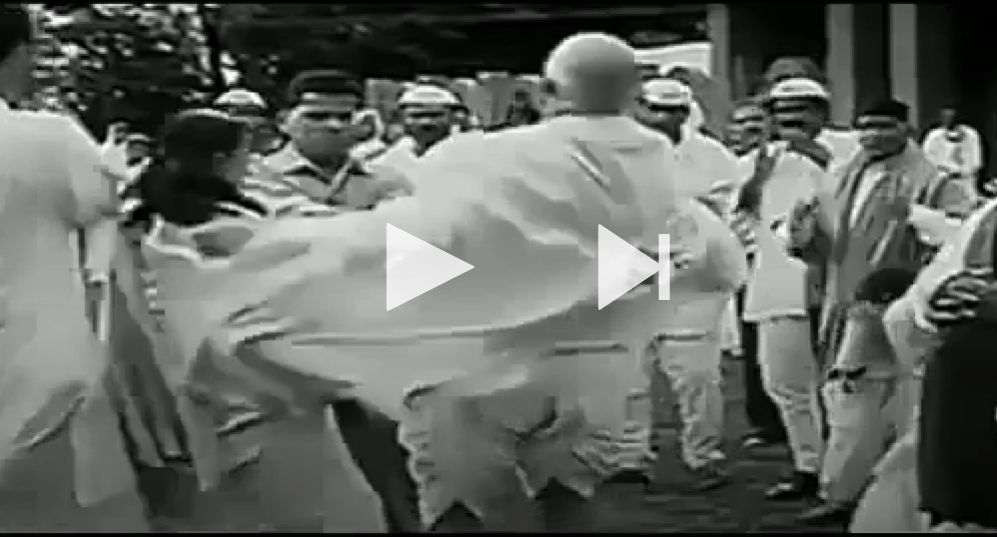
From act to
acting
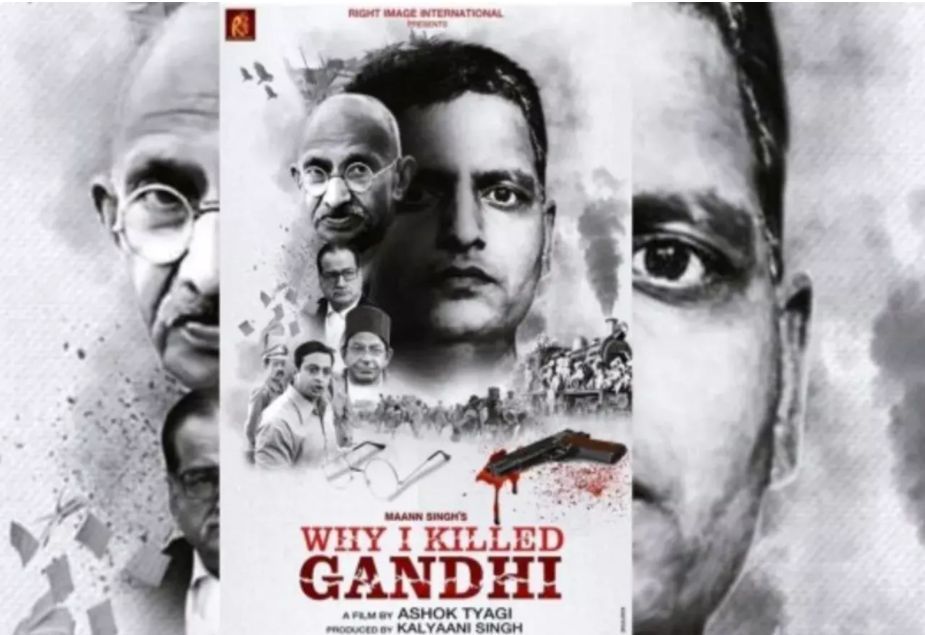
Mahatma Gandhi was assassinated on 30 January 1948 at age 78 in central
New Delhi. His assassin was Nathuram Vinayak Godse, a Brahmin from Pune, a
Hindu nationalist, a member of the political party, the Hindu Mahasabha, and a
former member of the Rashtriya Swayamsevak Sangh
(RSS), a right-wing Hindu paramilitary volunteer organization. Godse considered
Gandhi to have been too accommodating to Muslims during the Partition of India
of the previous year.
Clearing his position on the recent controversy over NCP leader and
television actor Amol Kolhe playing the role of Nathuram Godse in the film,
Deputy Chief Minister Ajit
Pawar said that there was no point in examining decisions a person took
when he was not involved with the party."He
became a member of the NCP in 2019, and his ideological position since then is
in front of everybody," Pawar said, adding that "I spoke to him about
the issue, and he told me that he had been contracted for that role in 2017 and
he accepted the role as an artist."
Several BJP leaders, in turn, are taking
a swipe at the opposition. However is no doubt, at any rate, about
where Godse got his intellectual inspiration or about his reasons and goals. At
his sentencing on November 8, 1948, Godse read along (book-length) statement of
self-explanation, justifying his assassination for posterity. Although the
statement was not permitted publication, it gradually leaked out to the public.
Translations into Indian languages began appearing, and in 1977 the English
original was published by Godse's brother Gopal under the polite title, May it Please
Your Honour. With an extended epilogue by Gopal, a
new edition was published in 1993 under the more precise title Why I
Assassinated Mahatma Gandhi. Today, the statement is also widely available on
the Internet. Godse is a hero on Hindu right websites, revered as a hero, and
entirely devoted to his career (www.nathuramgodse.com), as "The True
Patriot and the True Indian." (This website also contains the text of a
Marathi-language play glorifying Godse that has been banned in India.)
Like Savarkar's Hindutva, Godse's self-justification sees recent events
against the backdrop of centuries of "Muslim tyranny" in India,
punctuated by the heroic resistance of Shivaji, the Hindu emperor. He carried
on a military campaign against the Moghul rulers in the eighteenth century with
brief success. Like Savarkar, he describes his goal as creating a strong, proud
India that can throw off the centuries of domination.
Ripping up this vision of Gandhi was an important part of Savarkar's
politics. For only then could he have thought of making his politics succeed?
Savarkar had some advantages. The vision he espoused was easy to convey to
those who shared his obsession with Brahmin ascendency in politics, projecting
Muslims as enemies of their faith-based nationalism to unite various castes of Hindus without altering the
hegemony of the traditional social elite.
Members of the RSS (the parent organization of Vishwa Hindu Parishad)
and prominent Hindu thinkers in India and abroad were reportedly invited to
Mumbai (then Bombay) in India in August 1964. According to published reports,
it was decided that a new organization named Vishwa Hindu Parishad would be
formed and launched two years later, in 1966, at a world convention of Hindus.
Soon after its inception, the VHP focused on the Ramjanmbhoomi (birthplace of Lord Ram) issue
in Ayodhya, India. Hindu extremists allege that the Babri mosque is built
in Ayodhya, in the western state of Uttar Pradesh, is the birthplace of Lord
Ram (a revered Hindu God). Hindu fundamentalists, including the VHP, have
propagated the notion that the Babri mosque is "replaced" by a Hindu
temple of Ram at the disputed site.
Later the RSS would support the Bharatiya Janata Party (BJP) and its chosen
representative after Prime Minister A. B. Vajpayee started his RSS organizer.
Today Godse is something of a hero on BJP and RSS
websites. Picturing the atmosphere at the time Nehru, believed that the murder of
Gandhi was part of a "fairly widespread conspiracy" on the part of
the Hindu right to seize power; he saw the situation as analogous to that in
Europe on the eve of the fascist takeovers. And he believed that the RSS was
the power behind this conspiracy.
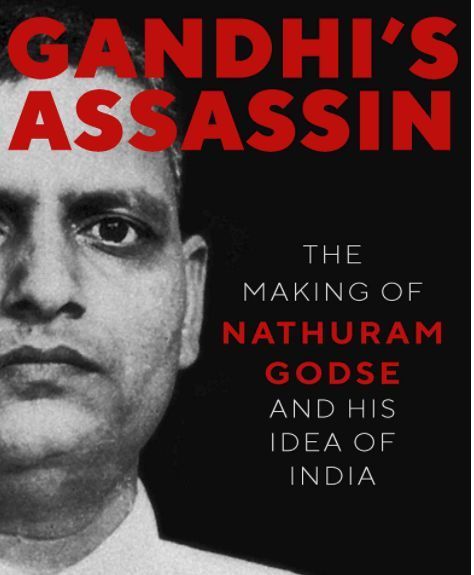
There is no doubt, as is explained in the above book, where Godse got
his intellectual inspiration or about his reasons and goals. At his sentencing
on November 8, 1948, Godse read along (book-length) statement of
self-explanation, justifying his assassination for posterity. Although the
statement was not permitted publication, it gradually leaked out to the public.
Translations into Indian languages began appearing, and in 1977 the English
original was published by Godse's brother Gopal under the polite title, May it
Please Your Honour. With an extended epilogue by
Gopal, a new edition was published in 1993 under the more precise title Why I
Assassinated Mahatma Gandhi. Today, the statement is also widely available on
the Internet. Godse is a hero on Hindu right websites, revered as a hero, and
entirely devoted to his career (www.nathuramgodse.com), as "The True
Patriot and the True Indian." (This website also contains the text of a
Marathi-language play glorifying Godse that has been banned in India.)
Like Savarkar's Hindutva, Godse's self-justification sees recent events
against the backdrop of centuries of "Muslim tyranny" in India,
punctuated by the heroic resistance of Shivaji, the Hindu emperor. He carried
on a military campaign against the Moghul rulers in the eighteenth century with
brief success. Like Savarkar, he describes his goal as creating a strong, proud
India that can throw off the centuries of domination.
Ripping up this vision of Gandhi was an important part of Savarkar's
politics. For only then could he have thought of making his politics succeed?
Savarkar had some advantages. The vision he espoused was easy to convey to
those who shared his obsession with Brahmin ascendency in politics – projecting
Muslims as enemies of their faith-based nationalism to unite various castes of
Hindus without altering the hegemony of the traditional social elite.
Members of the RSS (the parent organization of Vishwa Hindu Parishad)
and prominent Hindu thinkers in India and abroad were reportedly invited to
Mumbai (then Bombay) in India in August 1964. According to published reports,
it was decided that a new organization named Vishwa Hindu Parishad would be
formed and launched two years later, in 1966, at a world convention of Hindus.
One of the highlights of Gandhi's Assassin book is that
Godse’s, which he had given in the first week of March 1948, eight months
before he read out his much-publicized statement in court. Recorded before the
beginning of the trial in the Gandhi murder case, it seems to have been ignored
by generations of academics and journalists. Even though this statement, unlike
the one which Godse delivered in court, is in total conformity with the
archival records of the time. A unique source of concise information about the
life history of the assassin, the pretrial statement never mentions Godse’s
departure from the RSS after he became a member of the Hindu Mahasabha;
instead, it reveals that he was working for both organizations simultaneously.
The larger context
Soon after its inception, the VHP
focused on the Ramjanmbhoomi (birthplace of
Lord Ram) issue in Ayodhya, India. Hindu extremists allege that the Babri
mosque is built in Ayodhya, in the western state of Uttar Pradesh, is the birthplace of Lord
Ram (a revered Hindu God). Hindu fundamentalists, including the VHP, have
propagated the notion that the Babri mosque is "replaced" by a Hindu
temple of Ram at the disputed site.
Later the RSS would support the Bharatiya Janata Party (BJP) and its chosen
representative after Prime Minister A. B. Vajpayee started his RSS organizer.
Today Godse is something of a hero on BJP and RSS
websites. Picturing the atmosphere at the time Nehru, believed that the murder
of Gandhi was part of a "fairly widespread conspiracy" on the part of
the Hindu right to seize power; he saw the situation as analogous to that in
Europe on the eve of the fascist takeovers. And he believed that the RSS was
the power behind this conspiracy.
Thus, the BJP is associated with a network of organizations called the
Sangh Parivar (Family of Associations). In this sense, the successful
maintenance of a coalition led by an explicitly religious-nationalist political
party directly bears the literature on coalition formation and maintenance.
The Sangh Parivar includes three
frontline groups, the Rashtriya Swayamsevak Sangh
(RSS, National Organisation of Volunteers), the
Vishwa Hindu Parishad (VHP, World Hindu Council), and an associated student
organization called the Akhil Bharatiya Vidyarthi
Parishad (ABVP, All India Student's Council). The Hindu nationalist agenda is
also pushed forth by ancillary organizations not commonly associated with
religious fundamentalist groups, such as labor unions, think tanks, or rural
development organizations.
In such contexts, the notion that Hindu nationalism and Indian nationalism
formed two distinct ideologies had little meaning. Despite the emergence of
the Hindu Sabha movement in the early twentieth century in the north and
northwest India, the lines of opposition between Hindu nationalism and
Congress nationalism remained only very vaguely drawn. The evidence suggests
that there was a constant blending and borrowing of ideas. This was
demonstrated graphically by the fact that many prominent figures in the INC and
the Indian national movement more generally were also involved in the
developing Sabha movement.
Belonging
to an umbrella led by the Rashtriya Swayamsevak
Sangh (RSS) underneath supporters of the Vishva Hindu Parishad:
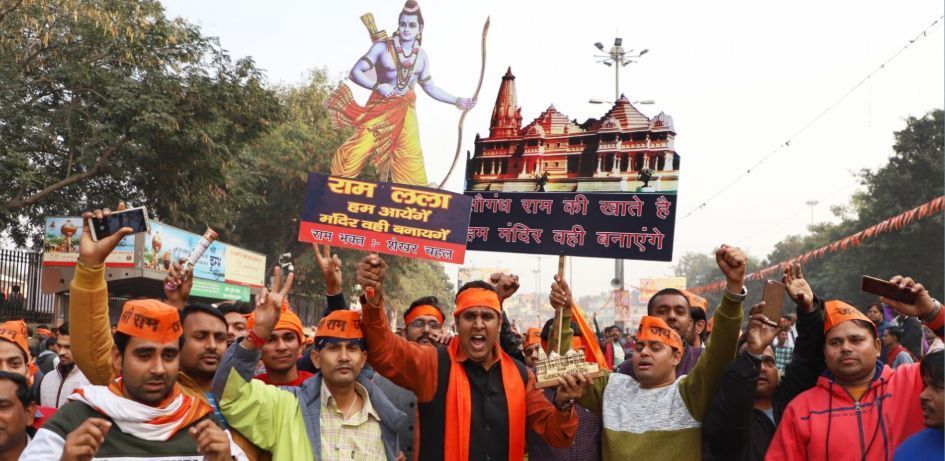
The BJP added a caste approach to its Hindutva politics. In India,
there are several parties whose main support base is in the lower castes who
are oppressed by the higher castes and who demand some equity (such as reserved
places in government jobs and educational institutions). The BJP launched a
demagogic attack on these parties on the grounds that they have caste biases,
but at the same time appealing to those castes that the caste-based parties
have traditionally ignored.
The BJP also gave political cover and recognition to brazenly
communalist candidates associated with the RSS and its affiliates, including
some accused of terrorism. This was done in order to valorize Hindu chauvinism
and to suggest that violence against non-Hindus is legitimate. They included
one, Pratap Sarangi, who is the former leader of a hardline right-wing group,
the Bajrang Dal. Members of the group were convicted of the brutal
murder of Australian Christian missionary Graham Staines and his two
children in 1999.
The road to a Hindu only
nation
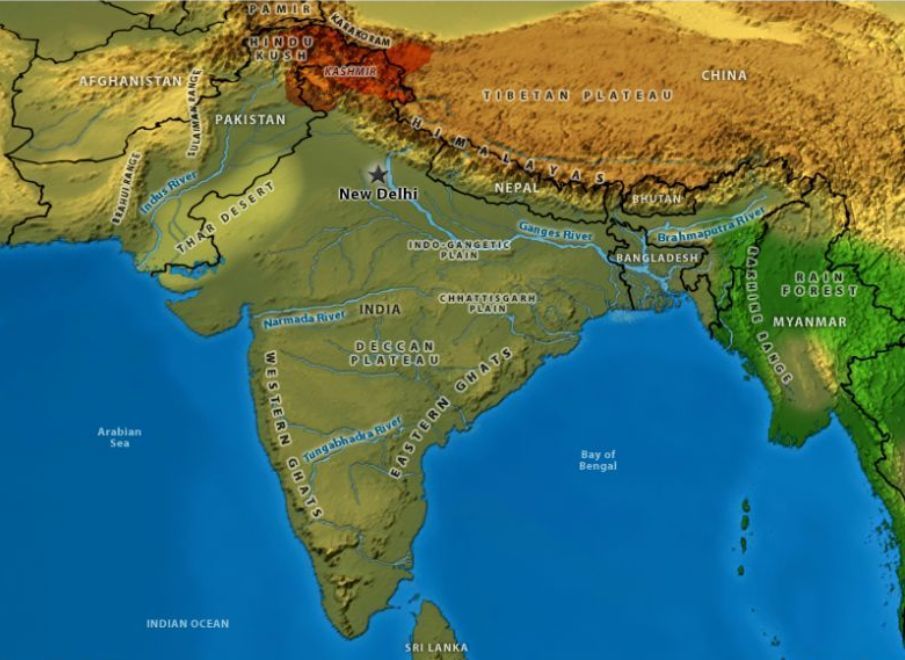
In their conception of the nation, which was enshrined in India’s
liberal constitution adopted in 1950 and set the tone of public life for
decades after the end of colonial rule, India should be a secular state that
belongs equally to all members of its complex multifaith society, whether from
the large heterogeneous Hindu majority or smaller communities that follow the
Semitic religions of Islam and Christianity, which have also flourished for
centuries in the subcontinent. But the militant Hindus who tore down the Babri
Masjid, and their powerful political patrons from the Bharatiya Janata
Party (BJP) and its parent organization the Rashtriya Swayamsevak
Sangh (RSS), saw things differently.
Influenced by Hindutva, a word that literally means Hindu-ness but has
come to stand for the Hindu nationalist political ideology, they believe that
India belongs first and foremost to Hindus.
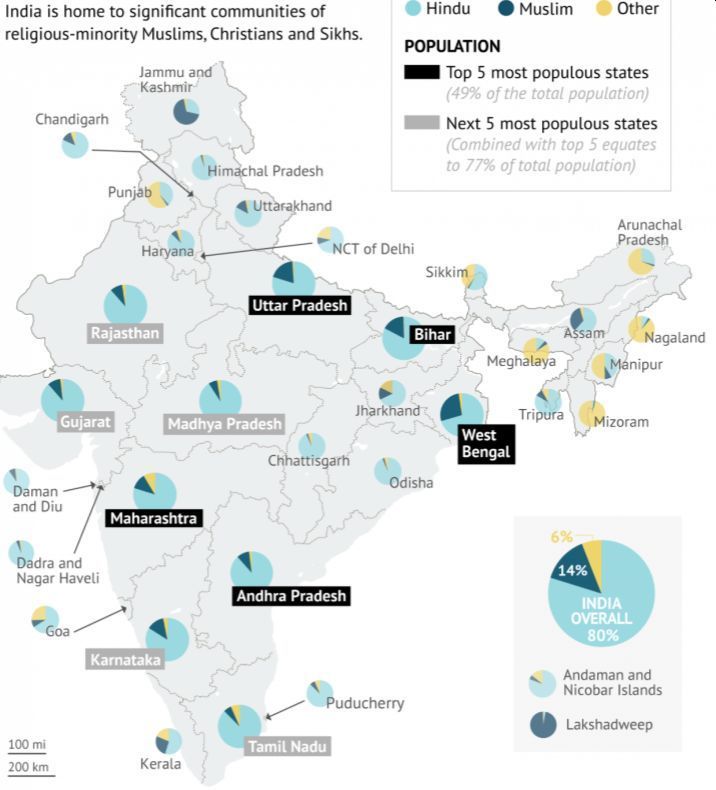
The January 1948
assassination of Mahatma Gandhi by Nathuram Godse, cast a long shadow over the
RSS, which was briefly banned and struggled for decades to regain public
legitimacy. But today, the debate is once again intensifying, as Prime Minister
Narendra Modi, a dedicated
RSS activist since his youth, won a second
five-year mandate from India’s estimated 900 million eligible voters.
And to judge from the
results of the election, the pluralist idea of India is receding into the past. At the polls, 44 percent of Hindus,
a larger proportion than ever before, voted for the ruling Bharatiya Janata Party (BJP), which seeks to transform India into a
Hindu nation. According to public opinion surveys conducted between 2016
and 2018 by researchers at the Centre for the Study of Developing Societies and
Azim Premji University, a majority of Hindus, including those who vote for
other parties, now profess support for some of the BJP’s most important Hindu
nationalist positions. This was also the first Indian election in which no
major political party challenged the BJP’s position that India’s Hindu majority
constitutes a single community that can rightfully claim ownership of the
nation. Today, the basic struggle in Indian politics is not over whether Hindus
and Hinduism should enjoy privileged status but over the precise legal and
constitutional forms that privilege will take.
The idea of India
Early on in 1997, the
historian Sunil Khilnani described "the idea of India,” usually attributed
to the country’s first prime minister, Jawaharlal Nehru, as an imagined
secular, pluralist, polity that belonged to all Indians and not to any one
group. In particular, India did not belong to the Hindu majority, which
constituted 80 percent of the country’s population according to the last
official census. It was this secular idea that created India in 1947, not as
the Hindu mirror of a Muslim Pakistan, but as the pluralist opposite of
majoritarian nationalism.
Now, things have changed. With the BJP’s rise to become India’s
governing party, the idea of India is being redefined to mean a Hindu polity.
Through acts of violence as well as words and laws, India is debating not
whether the country’s political system should recognize Hindu identity, but the
precise way in which it should be recognized.
The BJP, which has for decades called upon the government to recognize
the special rights of Hindus in a Hindu majority country, has been the single
most important force in shifting the terms of the debate.
As a committed RSS
man, Prime Minister Narendra Modi believes in turning India
into a theocratic Hindu state, where citizenship is defined on the basis of
being a Hindu.
Thus after promises, Narendra Modi has
come true to his word, energizing his supporters and exasperating his
opponents in equal measure. On Aug. 5, Modi began a process to revoke the special autonomous
status of the disputed territory of Jammu and Kashmir, igniting a political
firestorm in New Delhi and, potentially, tensions with nuclear archrival
Pakistan. In line with Modi's directive, Indian President Ram Nath Kovind
issued a presidential decree supplanting the Indian Constitution's Article 370,
which grants Jammu and Kashmir autonomy in managing its internal affairs with
the exception of defense, foreign affairs, and communications. What's more, the
decree will also impact Article 35A, which restricts non-Kashmiris from buying
land in the state, potentially opening the way for non-Kashmiris and Hindus to
migrate to the state and alter its Muslim-majority demographics.
Reflecting its Hindu nationalism, Uttar Pradesh Chief Minister Yogi
Adityanath has renamed Allahabad, a Hindu holy city bearing a distinctly Muslim
name, with the Hindu-inflected "Prayagarj."
He has also renamed the Faizabad district after one of its towns, Ayodhya,
a locality in which Hindu nationalists have demanded to construct a temple to
Ram over the ruins of the 16th-century Babri Mosque.
Whose Hinduism?
This soft pro-Hindu view, often found among those who have joined the
BJP directly (that is, not by way of the RSS or its affiliated organizations),
challenges the above-mentioned Nehruvian idea of a state equidistant from all
religions. That idea is currently enshrined in law: the Indian state does not
privilege Hindu religious holidays. Government offices closed for the holidays
of all major religious groups.
If the first-among-equals view was to become law, it would not
necessarily entail inequality in legal or material rights and entitlements, but
it would leave non-Hindus lesser owners of their country in a symbolic sense.
In addition, it would place those Hindus who do not follow whichever branch of
the religion the state ended up recognized in the same position. If the state
is going to mark Hindu holidays, for instance, it would have to decide whether
to privilege Diwali (the biggest festival of the year for many north Indian
Hindus), Durga Puja (the major festival of Hindus in West Bengal), Ganesh
Chaturthi (for those in the west of India), or Onam (the major Hindu festival
in Kerala). The pluralist idea of India avoided this problem entirely.
The second argument, calling it majoritarianism, goes further. India,
it holds, should adopt laws that privilege its Hindu majority while giving
non-Hindus diminished legal status. This is the standard position the BJP and
many of its leaders have articulated over the last two decades. If
majoritarianism were to prevail, India’s non-Hindu minorities would become
second-class citizens. Many Hindus might become second-class citizens, as well.
Nationalism ascendant
This includes Nehru’s
successors who gave up on that pluralist idea long ago. His daughter, Indira,
stoked the anxieties of the Hindu majority in her election campaigns in the
early 1980s. His grandson Rajiv Gandhi courted the Hindu majority by launching
his 1989 election campaign from the town of Ayodhya and calling for
“Ram Rajya,” the rule of Lord Ram. Now, his great-grandson Rahul Gandhi, the
current leader of the Congress Party, has begun to flash his own pro-Hindu
credentials. During regional elections last year, he made
conspicuous visits to temples. In anticipation of the
2019 parliamentary elections, he set off on a
pilgrimage to Mount Kailash in Tibet, which many Hindus
consider to be the home of the deity Shiva. On the way, he tweeted that “Shiva
is the universe,” and published Fitbit data showing each of his stops along the
pilgrimage route, turning what could have been a private visit into a political
spectacle. Days later, the Congress party put up election-related
posters declaring Gandhi a devotee of Shiva. This half-hearted attempt at
beating the BJP at its own game ensures that some form of Hindu majoritarianism
will win in India’s 2019 parliamentary elections, no matter who loses.
Kashmir
the BJP yoked its Hindutva agenda to its nationalist (mainly,
anti-Pakistan) agenda. The impact of nationalism and Hindutva peddled
separately would be less than when they are made to work in their mutual
interaction. The BJP’s portrayal of Pakistan as the mortal enemy is related to
the perceived loyalty of Indian Muslims to Pakistan: Pakistan was used as a
euphemism for Indian Muslims.
It is also to be expected
that Narendra Modi did tighten the central government's control over Kashmir encouraging the migration of
non-Kashmiri Hindus into the region and drawing investment from outside the
state.
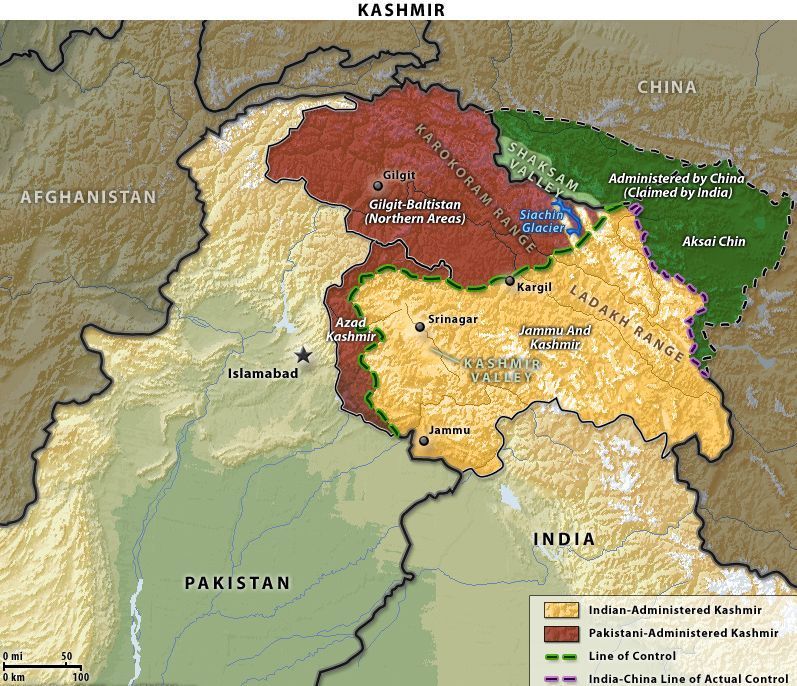
Already early on Modi began
a process to revoke the
special autonomous status of the disputed territory of Jammu and Kashmir,
igniting a political firestorm in New Delhi and, potentially, tensions with
nuclear archrival Pakistan. In line with Modi's directive, Indian President Ram
Nath Kovind issued a presidential decree supplanting the Indian Constitution's
Article 370, which grants Jammu and Kashmir autonomy in managing its internal
affairs with the exception of defense, foreign affairs, and communications.
What's more, the decree will also impact Article 35A, which restricts
non-Kashmiris from buying land in the state, potentially opening the way for
non-Kashmiris and Hindus to migrate to the state and alter its Muslim-majority
demographics.
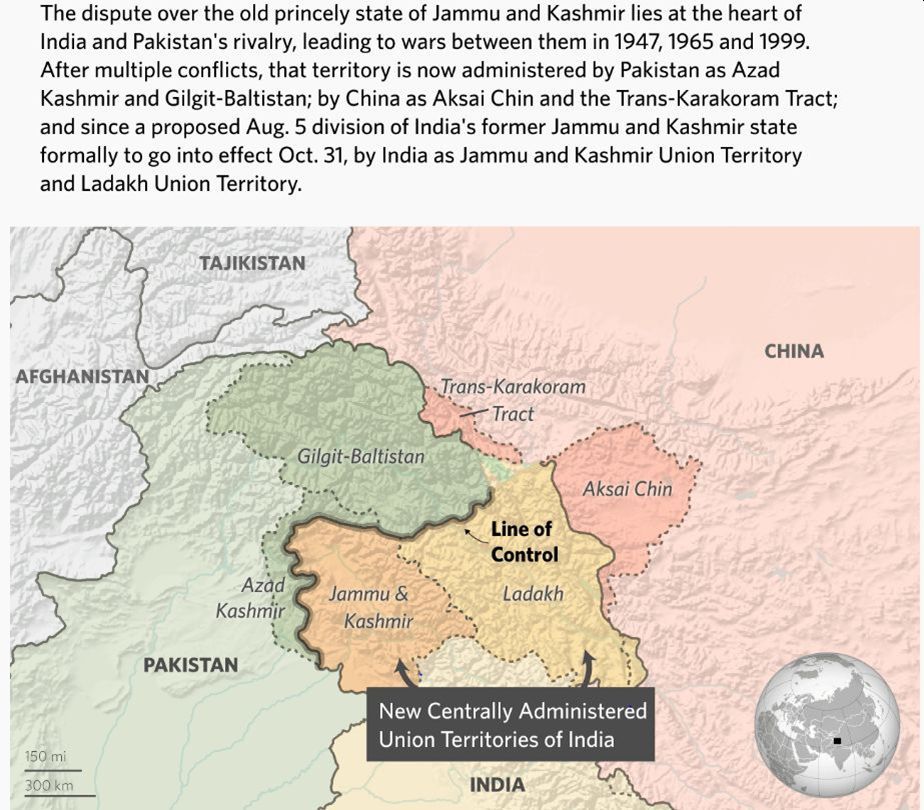
The Kashmir dispute contains
overlapping domestic and international components. Domestically, it
highlights the tension between the central government in New Delhi, which is
trying to assert its authority over a peripheral state that harbors a deeply
ingrained culture of autonomy that predates independence in 1947. India's only
Muslim-majority state, Kashmir's special constitutional status under Article
370 has always been a point of contention for the BJP, whose Hindu nationalist
base has agitated for the state's greater integration with the country.
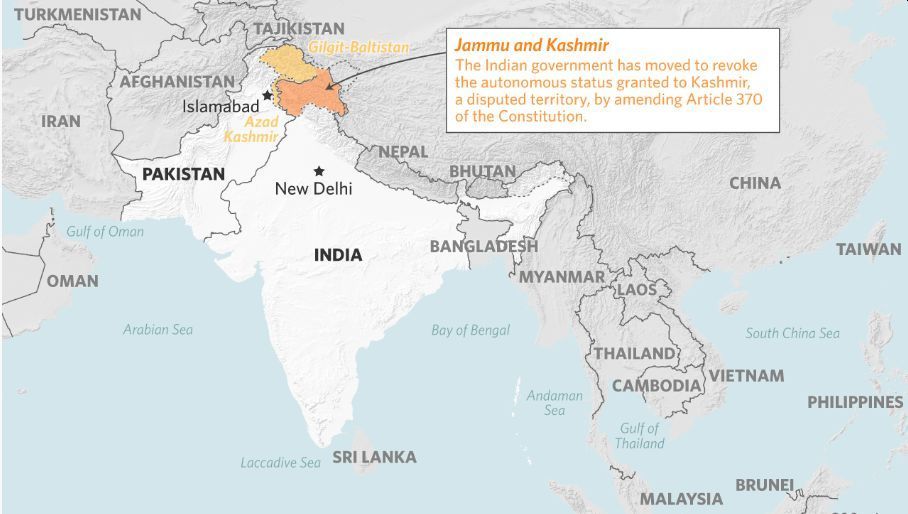
Kashmir thus also lies at the heart of India and Pakistan's decades-old
rivalry. Pakistan claimed Kashmir on the grounds that its Muslim-majority
population justified its inclusion in Pakistan, the homeland for the Muslims of
British India. India, however, argued that a Muslim-majority state was at home
in the new country's secular framework, which sanctioned no official state
religion in spite of the country's Hindu majority. Then there's the strategic
aspect of the countries' conflict over Kashmir, as the territory, which borders
China, Pakistan-administered Kashmir, and Punjab provides the Indian Armed
Forces with a critical staging ground in any potential conflict against China or Pakistan, India's
two most serious rivals. At the same time, Kashmir also has added importance
for Pakistan, as the country's key waterways run through the state.
For people today who forget that ‘map is not the territory, it is easy
to see why Kashmir is typically understood as a territorial dispute between two
belligerent neighbors in South Asia.
Jammu and Kashmir is a former princely state partitioned since 1949,
yet still regarded as a homogeneous entity. India and Pakistan control almost
half of its territory a small portion is occupied by China), with both claiming
jurisdiction over the whole. The line of demarcation is called the Line of
Control. Nevertheless, developments in the Pakistani part (made up of Azad
Kashmir and the Northern Areas) simply do not figure in the debates on Kashmir,
while stories of Kashmiris seeking to break away from the part administered by
India distort reality by overlooking the region's complexities. The political
construct of a Muslim-majority Jammu and Kashmir state pitted against a
majoritarian Hindu India-or of an Islamic bond cementing the relationship
between Azad Kashmir and the Northern Areas with Pakistan-is, at best,
misleading.
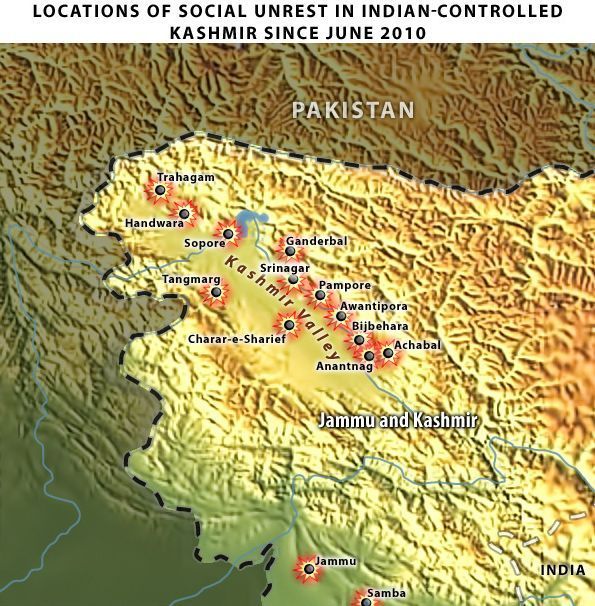
Pakistani Prime Minister Imran Khan's release of a captured Indian
pilot gave both countries an off-ramp, but the BJP used the incident to
prioritize national security.
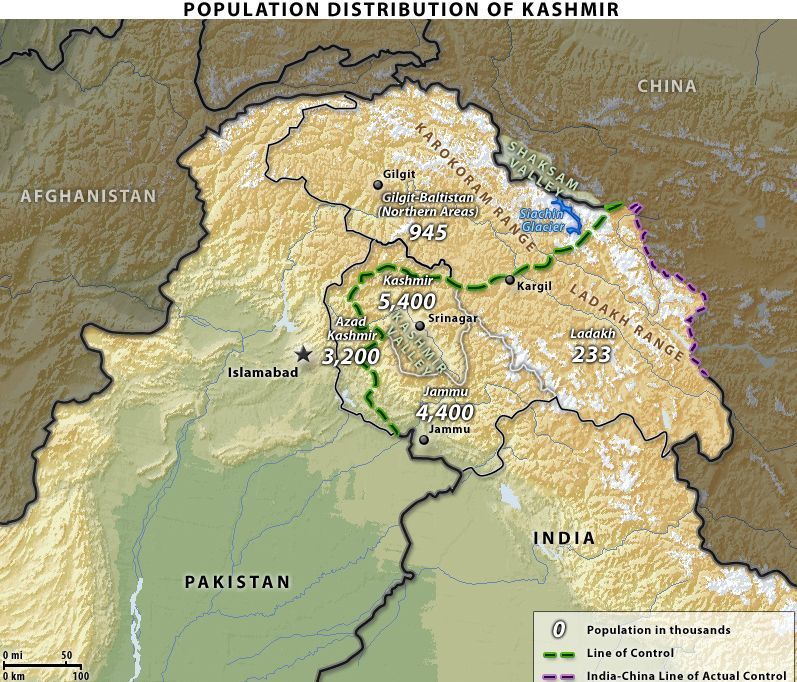
Foreign policy and China
India's fears of Chinese strategic encirclement will accelerate
its investment and defense overtures to neighboring countries in South Asia,
marking a central plank of Modi's foreign policy in 2020. However, Beijing's
funding advantages over New Delhi and its willingness to renegotiate debt with
Sri Lanka and the Maldives explain why its political and economic relationships
with these countries, as well as with Nepal and Bangladesh, will only grow.
Chinese infrastructure has
been observed, showing that China continues to hold positions in areas
within India’s
perception of the Line of Actual Control. Also, it took China until 18 February 2021 to admit that four of its soldiers died although
as the link to the article explains China, in reality, lost 43 of its men
during a bloody Himalayan border clash with Indian troops back in June last
year.
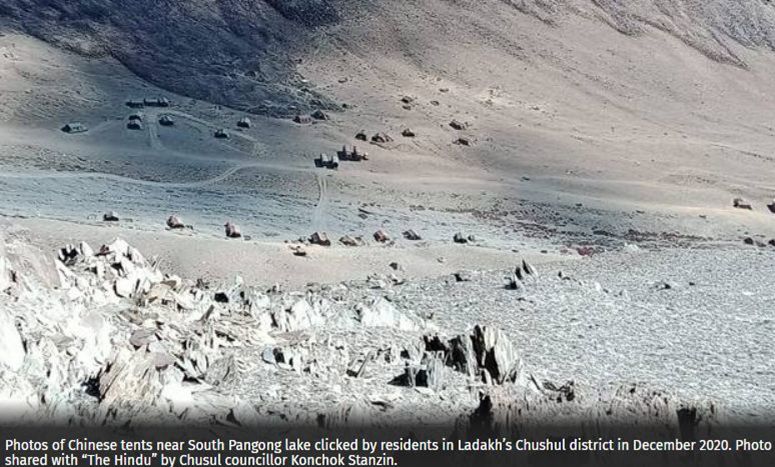
China is building a bridge across the Pangong Lake in the frontier
region of Ladakh in Indian-administered Kashmir, raising fresh security
concerns in India.
The 400-meter-long and 8-meter-wide bridge being constructed near
the Line of Actual
Control (LAC), the de facto border between the two nuclear powers, was
spotted through high-resolution satellite images, Indian media reports said
last week.
Last week, an Indian parliamentarian belonging to the ruling Bharatiya Janata Party (BJP) accused China’s People
Liberation Army (PLA) of abducting an
Indian teenager from the border state of Arunachal Pradesh.
For
updates click homepage here